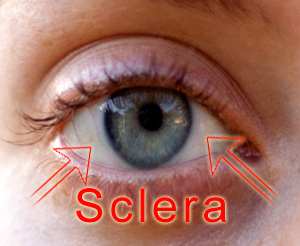| |
What is Scleritis?
Scleritis is an inflammatory disease that
affects the conjunctiva, sclera, and episclera (the connective tissue
between the conjunctiva and sclera). It is associated with underlying
systemic diseases in about half of the cases. The diagnosis of scleritis
may lead to the detection of underlying systemic disease. Rarely,
scleritis is associated with an infectious problem.
The affected
area of the sclera may be confined to small nodules, or it may cause
generalized inflammation. Necrotizing scleritis, a more rare, serious
type, causes thinning of the sclera. Severe cases of scleritis may also
involve inflammation of other ocular tissues.
Scleritis affects
women more frequently then men. It most frequently occurs in those who
are in their 40's and 50's. The problem is usually confined to one eye,
but may affect both. |
|
Common symptoms are: blurred vision, double
vision, sensitivity to light (photophobia) and
eye pain. You may also experience tears in the
surface of the sclera, patches may turn red or
violet or the sclera may lose its normal
coloring. If you experience any of these
symptoms, schedule an appointment with your eye
doctor immediately.
The affected
area of the sclera may be confined to small nodules, or it may cause
generalized inflammation. Necrotizing scleritis, a more rare, serious
type, causes thinning of the sclera. Severe cases of scleritis may also
involve inflammation of other ocular tissues.
DETECTION AND DIAGNOSIS
Along with visual acuity
testing, measurement of intraocular pressure, slit lamp examination, and
ophthalmoscopy, the doctor may order blood tests to rule out diseases
affecting the body. If involvement of the back of the eye is suspected,
the doctor may order imaging tests such as CT Scan, MRI, or
ultrasonography of the eye. |
| |
|
What is the
sclera?
The sclera is the white part of your eye. Made
out of fibrous tissues that are similar to those
found in joints, the sclera extends from the
front of your eye to the back where the optic
nerve resides.
Unlike the cornea, which
is clear, the sclera is an opaque white color.
In children it may be more see-through, showing
more of the tissue underneath. This may give the
sclera a bluish tint. In adults, the sclera can
be a bit more yellow.
The sclera is held
in place by six tiny muscles. It is a strong,
protective part of your eye. |
|
 |
| |
What does the sclera do?
 |
|
To know what the sclera does, it's helpful
to know what the other parts of your eye do as
well. You can imagine your eye to be like
a camera. A camera has a bunch of different
parts that work together to take pictures, just
like your eye has many different parts- most of
which we can't see when we look at our own eyes.
Our eyes' iris is like the shutter. The
shutter is what controls how much light comes
into a camera. The pupil is like the opening of
the camera. The iris controls how much light
enters through the pupil. In the back of the
eye, we have the retina- just like the back of a
camera has a layer of light-sensitive film. The
film coating can be compared to the rods and
cones that send the data about what we're seeing
to our brain. Our eyes' lens is just like a
camera lens, controlling what we're focusing on
and how we're focusing on it.
|
The sclera
is like the camera body- protecting all the
sensitive working parts inside from getting
damaged. It also keeps any light from
getting into the eye. If you've ever used a film
camera and opened the back before the roll was
finished, you know how you can ruin film by
exposing it to too much light. Similarly, if our
eyes allowed light to get in through the whites,
we'd have too much light bouncing around to make
a cohesive picture. The sclera is an important
working part of the eye.
What
diseases or other problems can affect my sclera?
Luckily, not a lot of diseases
affect the sclera. As we learned above, the
sclera is designed to be a protective part of
your eye. It's pretty sturdy. That doesn't mean
it can't become damaged, injured or diseased.
When the sclera does become diseased, it may
happen very quickly, so it is very critical to
see an eye doctor right away, before problems
get worse.
Scleritis: The suffix “itis”
comes from Greek and means “inflammation”. So
when you see a medical term like “appendicitis”,
you can guess it means “inflammation of the
appendix”. Hepatitis, pancreatitis, and
bronchitis are some other good examples.
Hepatitis is inflammation of the liver,
pancreatitis is inflammation of the pancreas and
bronchitis is inflammation of the mucus
membranes in the bronchial tubes. |
| |
|
| |
FYI: Episcleritis
Episcleritis is actually an inflammation of the
thin membrane covering the sclera. If you know
that derm means skin and epidermis is the outer
layer of skin, you can guess what “episclera”
means.
Symptoms of episcleritis include
pink or purplish tinge to a normally white part
of the eye, a tear in the eye, sensitivity to
light, eye pain and eye tenderness.
Episcleritis is more common in children. If your
child complains of a burning pain in part of his
eye, it’s best to keep him from rubbing it and
rinse the area with saline. If you don’t have
saline, use clear fresh water. Never prod, poke
or put pressure on the eye. Only an
ophthalmologist is qualified to examine and
diagnose what is causing the pain. Make an
appointment immediately if you or your child
experience any of these symptoms.
|
| |
|
|